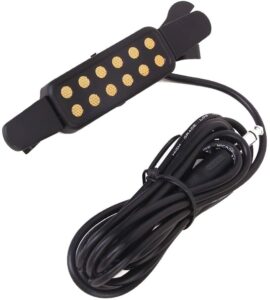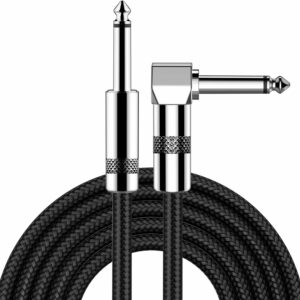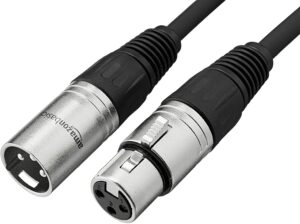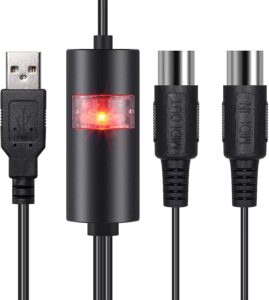Best Audio Cables
Best Acoustic Electric Guitar Cable

Best Electric Guitar Cable

Best Microphone XLR Cable

Best Keyboard Piano Midi Cable

But first – what is an audio cable?
Whether you’re a musician or not, you probably need an audio cable. Ultimately, your audio cables have an impact on the quality of sound coming from your instrument or electronic device.
Why do I need an audio cable?
If you care about sound, you need an audio cable. Audio cables are often overlooked and considered one of the least prominent parts of your music or audio setup. In reality, they’re like the veins of your electronics. (This goes for both newbie artists working off their laptops in a garage and professionals recording in a studio!)
Electrical properties of an audio cable
First things first. You should understand a few essential properties of audio cables. Audio cables should have very low measures of the following:
- Resistance: resistance should stay low and when it exceeds 5% it starts to have an effect on the performance of your sound. Minimize the length of your cable and maximize width when you can. Thicker wires are better at reducing resistance.
- Capacitance: capacitors hold electric charge. Low capacitance means that more of an instrument’s true or bright sound gets through to the speaker.
- Inductance: inductance occurs anywhere an electrical signal flows through a conductor. Inductance should be low in order to hear more frequencies.
What makes a great audio cable?
In order to ensure your audio cable has the correct resistance, capacitance, and inductance you should look at a few of the cable’s features. When we chose our best audio cables list, we looked at the following defining characteristics:
Type
The best way to classify the different types of audio cable is by their varied uses:
- Instrument cables: these cables directly connect instruments to an amplifier or speaker.
- Patch cables: this is a general term to describe cables that tend to be short and interconnect or link components together.
- Microphone cables: these cables connect microphones to speakers. They can also patch cables in order to link mixing boards to speakers.
- Speaker cables: these cables use larger wires due to the high voltage signals that they carry.
Internal audio transmitting materials
Ever wondered what the insides of your audio cables look like? There are both balanced and unbalanced cables. Balanced cables have two inner conductors. Unbalanced cables have a single inner core which carries electrical signals. Around the conductors, there is usually a braided or foiled shield so that if a wire bends it will still work correctly.
Exterior materials
The materials of an audio cable’s exterior determine its conductivity. Copper tends to be the most common material for cables due to its low cost and low resistance. While copper is the most popular material for the interior of audio cables, it oxidizes and must be well covered or insulated. Silver and gold are other options, both of which are pricier.
When it comes to the material on the exterior of your cable, focus on durability and flexibility. You want cables that can twist around your band set-up or can hit the road and endure some wear-and-tear.
Length for use
You want a cable that is long for ease of use but not too long. Cables that are long can have trouble finding a strong signal and might ultimately produce a lower quality sound. The sweet spot cable length is just around or under 10 feet.
Cable connector
The cable connector of your wire is the metal part at the end of the cable that connects to your instrument, speaker, or computer. Different types of audio cables have different connectors. TRS connectors typically connect balanced equipment to headphones. Something like an XLR connector usually connects microphones to mixers. TS cable connectors are best known for their connectivity with guitars. It’s worth also mentioning banana plugs. These connectors join audio wires to binding posts.
Best Acoustic Electric Guitar Cable

Turn your acoustic guitar electric by using this cable to plug it into an amplifier. For the price, this pickup produces solid sound. Speaking of sound, this cable preserves the guitar’s acoustic tone. Reviewers say that when you attach the pickup to the guitar it is out of the way of playing. The cable cord is an ideal 10 feet long.
Easy to install
This cord clips on to your guitar’s sound hole and connects to the audio input with a standard connector to produce a quality, electric sound.
Best Electric Guitar Cable

The straight to right angle ends on the metal connectors of these cables ensures secure connection to any instrument, pedal, or amp. We love it’s high-quality connectivity and ultimate sound for electric guitars. It works with mixers, power amplifiers, microphones, effectors, decoders, and other electronic equipment. The cable itself has a stretching intensity that is 30% higher than other average cables.
Enhanced sound
The 22AWG oxygen-free-copper center conductors provide top-notch signal transfer. That means your music will be clearer and fuller. The PVC insulation material provides noise rejection for quiet operation.
Best Microphone XLR Cable

Ranging in a variety of sizes this microphone cable is great for presenting, singing, studio recording, and performance. An Amazon’s basic, the microphone comes with a one-year warranty. Just plug in and play with XLR-compatible PA systems.
All copper conductors
The microphone cable has all copper conductors and inner copper spiral shielding. The cable’s shield reduces both interference and excess noise.
Best Keyboard Piano Midi Cable

Turn your computer into a recording studio with this audio cable. Connect most instruments to your computer with the cable and you’ll be able to record music directly to your laptop. The wire uses high quality copper materials and a high-performance FTP processing chip. This ensures it has stable signal and rapid data transmission. Test whether or not the cable is working with the LED indicator on the wire.
Painless installation
This cable is USB compatible, which means it comes with a built-in driver that you simply have to plug in to play. It functions with almost all computer systems, such as Windows XP, Vista, and Mac OS X operating systems.

